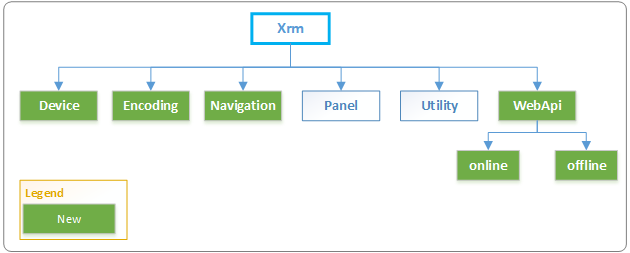Source:Dynamics 365
| Deprecated Client API | Replacement Client API | Comments |
|---|---|---|
| Xrm.Page | Forms: ExecutionContext.getFormContext Commands: Send it as the PrimaryControl parameter |
Xrm.Page is the primary form context. If a script is run on a secondary context (grid row, quick form, related entity) then Xrm.Page will be for the wrong form context. By using alternate methods of getting the form context we allow the same script to be used without modification in all contexts. |
| Xrm.Page.context | Xrm.Utility.getGlobalContext | Allows access to the global context without going through the form context. |
| Xrm.Page.context.getQueryStringParameters | formContext.data.attributes | The formContext.data.attributes API will make retrieval of non-entity bound data consistent across entity forms, metadata-driven dialogs, and task-based flows. The data will be a combination of custom values sent using the query string and what was specified in the parameters in the openForm method. |
| Xrm.Page.context.getTimeZoneOffsetMinutes | globalContext.userSettings.getTimeZoneOffsetMinutes | Moved to globalContext.userSettings |
| Xrm.Page.context.getUserId | globalContext.userSettings.userId | Moved to globalContext.userSettings |
| Xrm.Page.context.getUserLcid | globalContext.userSetings.languageId | Moved to globalContext.userSettings |
| Xrm.Page.context.getUserName | globalContext.userSettings.userName | Moved to globalContext.userSettings |
| Xrm.Page.context.getUserRoles | globalContext.userSettings.securityRoles | Moved to globalContext.userSettings |
| Xrm.Page.context.getIsAutoSaveEnabled | globalContext.organizationSettings.isAutoSaveEnabled | Moved to globalContext.organizationSettings |
| Xrm.Page.context.getOrgLcid | globalContext.organizationSettings.languageId | Moved to globalContext.organizationSettings |
| Xrm.Page.context.getOrgUniqueName | globalContext.organizationSettings.uniqueName | Moved to globalContext.organizationSettings |
| Xrm.Page.data.entity.getDataXml | No change in the method, but use "typename" instead of type for lookup attributes. | |
| GridRow.getData | GridRow.data | GridRow is essentially a form context. This change unifies the interface of GridRow with formContext. |
| GridRowData.getEntity | GridRowData.entity | GridRowData is form data. This change unifies the interface of GridRowData with formContextData. |
| Xrm.Mobile.offline | ||
| parent.Xrm | Earlier: An HTML web resource may interact with the Xrm.Page or Xrm.Utility objects within the form by using parent.Xrm.Page or parent.Xrm.Utility. Now: parent.Xrm.* will work if the HTML web resource is loaded in a form container. For other places, such as loading an HTML web resource as part of the SiteMap, parent.Xrm.* won’t work. | |
| addOnKeyPress | Use a custom control | |
| removeOnKeyPress | Use a custom control | |
| showAutoComplete | Use a custom control and corresponding UI | |
| hideAutoComplete | Use a custom control and corresponding UI | |
| Xrm.Utility.alertDialog | Xrm.Navigation.openAlertDialog | The new signature is consistent with other APIs (openForm) and takes a new set of parameters for flexibility. |
| Xrm.Utility.confirmDialog | Xrm.Navigation.openConfirmDialog | The new signature is consistent with other APIs (openForm) and takes a new set of parameters for flexibility. |
| Xrm.Utility.isActivityType | Xrm.Utility.getEntityMetadata | The isActivityType method is synchronous so it was suitable for ribbon rules. However, the replacement method, getEntityMetadata, is asynchronous, and is not suitable for ribbon rules. |
| Xrm.Utility.openEntityForm | Xrm.Navigation.openForm | Moving navigation actions to Xrm.Navigation |
| Xrm.Utility.openQuickCreate | Xrm.Navigation.openForm | Moving navigation actions to Xrm.Navigation |
| Xrm.Utility.openWebResource | Xrm.Navigation.openWebResource | Moving navigation actions to Xrm.Navigation Note: This API returns VOID in Unified Interface. |

